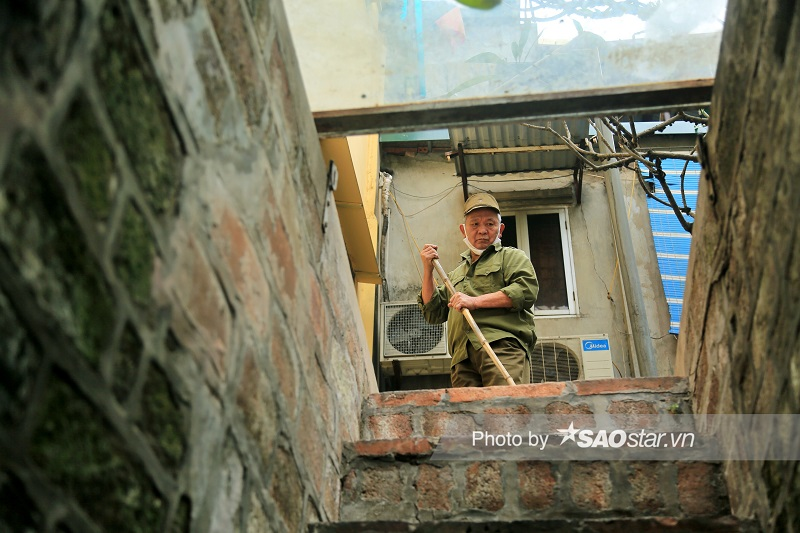At the age of 74, Mr. Ta Van Nhan has taken care of Quan Chuong Gate for over two decades, as a way to help preserve the historical and cultural relic of the city.
 |
| At the age of 74, Mr. Ta Van Nhan has taken care of Quan Chuong Gate for over two decades. Photo: Saostar.vn |
It’s not an exaggeration to say that the antiquity and firmness of the gate is preserved thanks to Mr. Nhan’s contribution. Born and raised in a house which is only about 50 meters from the gate, Mr. Nhan believes that his bond with the gate is a destiny.
Witnessing a lot of upheavals of Hanoi over the years, Mr. Nhan said that Quan Chuong gate still look the same as it was when he was a child and he wants to contribute to preserve this beauty.
 |
| Every day from 6am to 6pm, Mr. Nhan cleans the gate and area around it, prevents street vendors and others from using it for their personal purpose. Photo: Saostar.vn |
About twenty years ago, moss invaded the wall of the gate in the rainy season and wild plants plagued all over it. Sometimes, street vendors occupied the gate for selling. It was a headache for the local authority as the local militia could not keep watch on the gate around the clock. Then Mr. Nhan volunteered to do the job.
Since then, every day from 6am to 6pm, Mr. Nhan cleans the gate and area around it, prevents street vendors and others from using it for their personal purpose.
 |
| The Quan Chuong is one among 21 gates of the ancient city that has remained today. Photo: Duong Chu |
It is not a hard job but requires much patience because he has to deal with all kinds of persons, according to Mr. Nhan. There are some people were angry with him when being caught littering at the gate. “Some even insult me. I was very annoyed and sometimes I wanted to quit. But it is hard to find my replacement so I continue it,” he said.
Besides guarding the gate, Mr. Nhan also offers incense and performs worshiping ritual ceremonies for the gate tutelary genie. “For me it is like my second home with many memories. I hope that the next generations would also keep this gate clean and beautiful to fulfill its function as a welcoming place for all visitors,” he said, before adding that he would take care of it as long as he lives.
 |
| Photo: Saostar |
 |
| Photo: Saostar |
Old city gate Hanoi (O Quan Chuong)
 |
| The O Quan Chuong Gate was a large thick wooden gate where at night the soldiers closed it and opened it early morning for people to enter the ancient Thang Long citadel. Photo: Donic Chinh |
The only surviving gate of the citadel of Thang Long, O Quan Chuong not only brings beauty in architecture but also represents Hanoi ancient history.
According to records, in the reign of King Le Thai Tong (1740-1786) Thang Long has many gates such as Cau Giay, Cho Dua, Cau Dien or Quan Chuong. Each city gate was built as a gate, open day, night closed and fenced, with a guard to prevent thief, fire.
The remaining entrance to the last bastion of Thang Long is situated within the Old Quarter of Hanoi along with the other historical places of interest. The gate remains an exemplary evidence of traditional architecture prevalent during the rule of the Nguyen Dynasty. Sentries remain posted on the roof of the tower to date.
 |
| Photo: Vietnam Landmarks |
The Old City Gate had been constructed in 1743 and named Quan Chuong for a brave soldier who laid down his life trying to protect Hanoi from the French troops. The east gate played a strategic role in keeping the French army out again in 1846, after more than a century had passed by. It also had a significant role in keeping the Americans out during the Vietnam War that had been fought against all odds. It had been demolished multiple times as well only to be restored to its former glory every time. Strangely, each ruler or victorious side decided to rebuild the gate in exactly same manner thus remaining true to its original architecture. The last restoration work took place in 2010, almost 16 years after it had been recognized by the government as a historical site.
The present day structure of the Old City Gate can be found opposite the Red River. The ten feet high, double storey arched gate makes an imposing picture that is visible from afar. The visitors are seen looking up in wonder at the cupola of the grey colored tower built on the upper level of the gate. The Vietnamese National Flag can be seen fluttering as one comes near the tower. Most tourists are amazed to find an inscription on a small column placed near the entrance, ordering the military to safeguard the local populace.
The Old City Gate of Hanoi is situated at the crossroad of the Hang Chieu road and Dao Duy Tu Street. The backpack group preferring to reside in the Old Quarter can walk to the gate easily. The ones intent on visiting the Old Gate directly from the Airport can hop onto Bus No. 17 that terminates at the bus stop adjacent to the gate. Metered taxis are available for tourists who do not want walk to the Old Quarter while solitary visitors would do well to hire a Xe Om (motorcycle taxi) at a modest price of VND 15,000 to VND 20,000 for a 20 minute ride.



